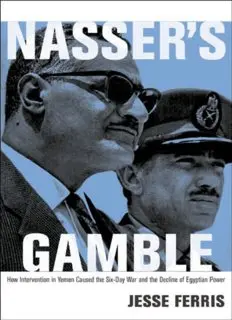
Nasser’s Gamble: How Intervention in Yemen Caused the Six-Day War and the Decline of Egyptian Power PDF
Preview Nasser’s Gamble: How Intervention in Yemen Caused the Six-Day War and the Decline of Egyptian Power
Nasser’s Gamble Nasser’s Gamble HOW INTERVENTION IN YEMEN CAUSED THE SIX-DAY WAR AND THE DECLINE OF EGYPTIAN POWER J F ESSE ERRIS PRINCETON UNIVERSITY PRESS PRINCETON AND OXFORD Copyright © 2013 by Princeton University Press Published by Princeton University Press, 41 William Street, Princeton, New Jersey 08540 In the United Kingdom: Princeton University Press, 6 Oxford Street, Woodstock, Oxfordshire OX20 1TW press.princeton.edu Jacket Photograph: Abdul Nasser Meets the Yemeni People. from al-Quwwat al-Musallahah, Egyptian weekly journal, supplement to volume 412, May 1, 1964. Courtesy of The Arabic Press Archive, Moshe Dayan Center, Tel Aviv University Israel. All Rights Reserved Library of Congress Cataloging-in-Publication Data Ferris, Jesse, 1972– Nasser’s gamble : how intervention in Yemen caused the Six-Day War and the decline of Egyptian power / Jesse Ferris. p. cm. Includes bibliographical references and index. ISBN 978-0-691-15514-2 (hardcover : alk. paper) 1. Egypt—Foreign relations—1952–1970. 2. Egypt—Military policy—History—20th century. 3. Nasser, Gamal Abdel, 1918–1970. 4. Yemen, North—History—Revolution, 1962—Participation, Egyptian. 5. Yemen (Republic)—History— 1962–1972. 6. Israel-Arab War, 1967—Egypt. I. Title. DT107.83.F47 2013 956.04’6—dc23 2012028784 British Library Cataloging-in-Publication Data is available This book has been composed in Palatino Printed on acid-free paper. ∞ Printed in the United States of America 1 3 5 7 9 10 8 6 4 2 Contents Acknowledgments INTRODUCTION The Golden Age of Nasserism Idealism and Pragmatism in Nasser’s Foreign Policy The Nature of Middle Eastern Politics The Place of the Intervention in Egyptian Memory Structure of the Book CHAPTER ONE The Road to War The Coup in Yemen The Struggle for Power in Egypt The Accidental Intervention? The Denouement of the Crisis in Cairo CHAPTER TWO The Soviet-Egyptian Intervention in Yemen The Nature of Soviet Relations with Egypt and Yemen The Egyptian Appeal and the Soviet Response Explaining Soviet Behavior Forms of Early Soviet Involvement CHAPTER THREE Food for “Peace”: The Breakdown of US-Egyptian Relations, 1962–65 Recognition Disengagement The Suspension of US Aid The Balance of Payments Crisis CHAPTER FOUR Guns for Cotton: The Unraveling of Soviet-Egyptian Relations, 1964–66 Guns for Cotton The Soviet Quest for Base Rights in Egypt From Jiddah to Moscow In the Cracks of Cold War Geology The Final Unraveling CHAPTER FIVE On the Battlefield in Yemen—and in Egypt Counterinsurgency Casualties Cost Corruption The Spread of Popular Discontent CHAPTER SIX The Fruitless Quest for Peace: Saudi-Egyptian Negotiations, 1964–66 The First Arab Summit The Second Arab Summit The Jiddah Agreement From the Islamic Pact to the Long Breath Strategy The Kuwaiti Mediation and the Return of Sallāl CHAPTER SEVEN The Six-Day War and the End of the Intervention in Yemen The Sinai Option The Syrian Connection The Soviet Spark The Egyptian Initiative The Impact of the Yemen War on Egyptian Military Performance in the Six-Day War The Khartoum Conference and the Withdrawal of the Egyptians from Yemen AFTERWORD The Twilight of Egyptian Power Bibliographical Note Bibliography Index Map of Yemen ca. 1965. Acknowledgments THE OPENING LINES of a first book afford a singular opportunity to pay tribute to those who have shaped one’s growth as a scholar. My intellectual story begins with Donald Kagan, who taught me all about foxes. The late Bill Odom then tried to get me into hedgehogs. Michael Doran guided me into the labyrinth of Middle Eastern politics—and suggested that I “look at Yemen” and “take Russian.” I went to Stephen Kotkin seeking perspective on Russia and came away with a new approach to history. Many other distinguished colleagues and friends have helped shape this book. Şükrü Hanioğlu, who has been unstinting in his support, read several drafts and provided many helpful comments; so did Bernard Haykel, who shared his private library with me. Elie Podeh contributed expertise in Arab politics and valuable counsel along the way. Bernard Lewis furnished invaluable references and encouragement. L. Carl Brown read through the entire manuscript and provided many insightful comments. Mark Kramer and the editorial staff at the Journal of Cold War Studies helped refine the ideas contained in the second and fourth chapters. Michael Oren provided helpful advice and support at key junctures. Oscar Sanchez generously shared the results of his research. David Freedel, the best language instructor I have ever known, taught me Russian. The noble-hearted Musa Odeh transformed my Arabic. Gali Dagan, a true friend, endured many hours of conversation about Yemen. Vladimir Shubin, Alexei Vassiliev, Oleg Peresypkin, Constantine Truevtsev, Zaid al-Wazir, Qassim al-Wazir, and many others shared their reminiscences. Desmond Lachman and Yotam Margalit contributed economic expertise. Rachel Green and Maayan Ravitz-Shalom jealously guarded my time. Ira Bein, Frank Grelka, Shaul Levy, Rami Livni, and Baker al-Majali assisted with research. Shane Kelley designed the maps.
